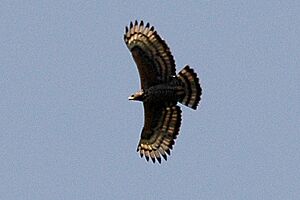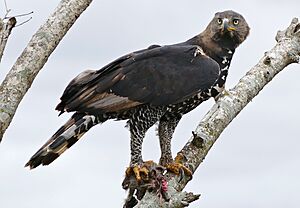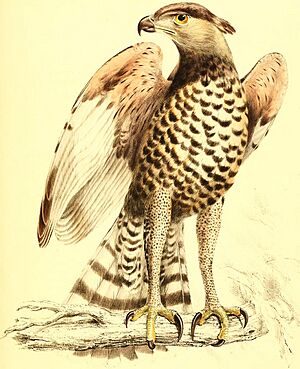Crowned eagle facts for kids
Quick facts for kids Crowned eagle |
|
|---|---|
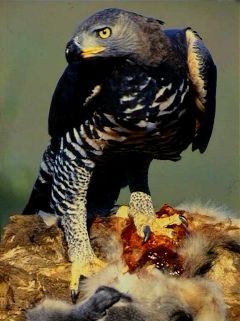 |
|
| A crowned eagle with its prey | |
| Conservation status | |
| Scientific classification | |
| Genus: |
Stephanoaetus
|
| Species: |
coronatus
|
 |
|
| Where crowned eagles live | |
| Synonyms | |
|
Falco coronatus Linnaeus, 1766 |
|
The crowned eagle, also known as the African crowned eagle or crowned hawk-eagle (Stephanoaetus coronatus), is a very large bird of prey. You can find it in sub-Saharan Africa, mostly in forests and woodlands near rivers. It's the only living species in its group, Stephanoaetus. Another species, the Malagasy crowned eagle, used to live on Madagascar but became extinct after humans arrived.
These eagles mainly eat mammals, which make up over 90% of their diet. They often hunt small ungulates like dik-diks and duikers. They also prey on primates such as young baboons, bushbabies, and monkeys. They rarely hunt birds or large lizards.
Even though the crowned eagle has a long tail, making it up to 90 cm (35 in) long, it's lighter and has a shorter wingspan than Africa's largest eagle, the martial eagle. However, it's known as Africa's most powerful eagle for its size. It can even hunt animals as heavy as 30 kg (66 lb), like young bushbucks. Crowned eagles have huge talons and strong legs, often killing prey by crushing their skulls. They are also very brave and fierce hunters.
The crowned eagle is often compared to the harpy eagle from Central and South America because they hunt in similar ways. These eagles are well-studied because they are bold and easy to spot. Sadly, their numbers are decreasing because their forest homes are being destroyed. Because of this, the IUCN now lists them as Near Threatened.
Contents
About the Crowned Eagle
The crowned eagle was first described by Carl Linnaeus in 1766. It belongs to a group called "booted eagles" because of the feathers on their legs. This group includes many other large eagles like the Aquila eagles and "hawk eagles."
Scientists once thought the crowned eagle was closely related to Asian hawk-eagles. However, newer studies show it's quite different from other "booted eagles." Interestingly, the much heavier harpy eagle has a similar skeleton, even though they are not closely related. This is an example of convergent evolution, where different species develop similar traits.
Another crowned eagle species, the Malagasy crowned eagle, lived until about 1500. It was similar in size and likely hunted lemurs in Madagascar. It probably died out because of habitat loss and a decrease in its prey, caused by early humans. Today, there are no different types (subspecies) of the living crowned eagle.
What Does a Crowned Eagle Look Like?
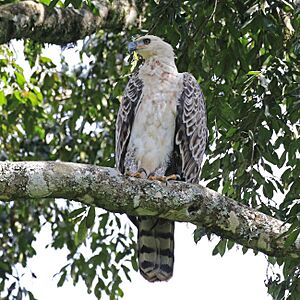
The crowned eagle is a very large bird. It measures from 80 to 99 cm (31 to 39 in) long, making it one of the longest eagles in the world. Female eagles are bigger than males, weighing between 3.2 and 4.7 kg (7.1 and 10.4 lb). Males weigh from 2.55 to 4.12 kg (5.6 to 9.1 lb).
Their wingspan is usually between 1.51 and 1.81 m (4 ft 11 in and 5 ft 11 in). This wingspan is quite short for such a large bird, but their wings are wide and rounded. This shape helps them fly easily through thick forests. Even though it's lighter and has a shorter wingspan than the martial eagle, the crowned eagle is longer because of its very long tail. Their tail can be 30 to 41 cm (12 to 16 in) long.
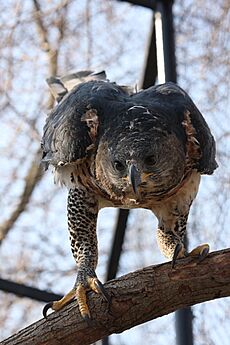
Their legs are strong and thick, and their talons are huge. The largest talon, called the hallux-claw, can be up to 6.2 cm (2.4 in) long. This is similar in size to the talons of the largest golden eagles.
Adult crowned eagles have striking colors. Their head is dark brown with a tall, black-tipped crest that can look like a triangle. Their upper body is blackish-brown with a blue tint. Their throat is brown, and their belly and chest are white with black bars and blotches. The underside of their wings is a bold chestnut color with black spots. Their eyes can be yellow or almost white. It's hard to mistake an adult crowned eagle for another bird because of its unique look and calls.
Young crowned eagles look very different from adults. Most young birds have a white head and underside, but their legs are heavily spotted with black. Their back is light brown or grayish-brown. As they grow, their colors change. Young eagles can sometimes be confused with young martial eagles, but the crowned eagle has a much longer, more barred tail and shorter wings.
Where Do Crowned Eagles Live?
Crowned eagles live only in Africa. In East Africa, they can be found from central Ethiopia down to eastern South Africa. In western and central Africa, they live across the large African rainforests, from Senegal to Angola. Even though they live in many places, they are becoming rare in parts of West Africa.
These eagles prefer dense woodlands and deep rainforests. They can also be found in smaller patches of woods, hillsides, and rocky areas. They live from sea level up to 3000 m (9,800 ft) high. Because their habitat is shrinking, their population is often spread out. In protected areas with old-growth rainforests, crowned eagles can still be found in good numbers.
How Do Crowned Eagles Behave?
Like most African raptors, crowned eagles don't migrate. They usually stay in the same area their whole adult lives. Young eagles, however, tend to wander more before they become adults.
Crowned eagles are very noisy birds, especially during their display flights. They make loud, rising and falling whistles. Males perform impressive dives and climbs high above the forest, calling loudly. They can fly over 900 m (3,000 ft) high during these displays. Females also display, but their calls are lower. Pairs sometimes fly together, even locking talons and falling a distance before separating.
These eagles are known to be nervous and always alert. They are very different from the calm eagles that live in open areas. Crowned eagles are thought to be intelligent, cautious, and curious. They can even live near towns if there's enough prey and tall trees for nesting and hunting. Wild adult eagles are often fearless of humans and can even be aggressive if you get too close to their nest. However, young eagles are much shyer and need a long time to learn how to hunt and defend themselves.
Breeding and Raising Young
Crowned eagles have one of the longest breeding cycles of any bird. A pair breeds only once every two years, and one cycle lasts about 500 days. This is much longer than most other eagles. The long period is mainly because young eagles stay with their parents for 9 to 11 months after they learn to fly.
Breeding can happen all year, but egg-laying usually peaks around the end of the wet season. Eagle pairs strongly defend their home areas, which can be very large. They build huge nests in the forks of tall forest trees, usually 12 to 45 m (39 to 148 ft) off the ground. The female brings most of the nesting material, while the male builds the nest.
A new nest can take up to 5 months to build, but eagles often reuse and repair old nests, which takes about 3 months. A nest can grow to be 2.5 m (8.2 ft) wide and 3 m (9.8 ft) deep after several years of use.
Crowned eagles usually lay 1 or 2 eggs. The eggs are mostly white, sometimes with red-brown spots. They are about 68.2 x 53.6 mm (2.69 x 2.11 in) in size. Incubation lasts about 49 days, with the female doing most of the work. If two eggs hatch, the older chick often outcompetes the younger one for food, or even kills it. In the wild, only one chick usually survives.
After the chicks hatch, the male eagle hunts more often, bringing food every 1.5 days. The young chick starts to grow feathers at 40 days old and is fully feathered by 76 days. They start flapping their wings around 45 to 50 days. Young eagles take their first flight (fledge) at 90 to 115 days old. After fledging, the young eagles stay near the nest and are fed by their parents for another 270 to 350 days. This long period helps them become strong and independent hunters. Most crowned eagles start breeding when they are about five years old.
What Do Crowned Eagles Eat?
The crowned eagle is often called the most powerful raptor in Africa. Its strength comes from its large feet and talons, and the size of the prey it hunts.
Their main diet is mammals. They typically hunt prey weighing from 1 to 5 kg (2.2 to 11.0 lb). However, in some rainforest areas, their average prey weight can be as high as 5.67 kg (12.5 lb). The crowned eagle is perhaps the only living eagle that regularly attacks prey heavier than 9 kg (20 lb). They can even hunt animals up to 20 kg (44 lb). Some reports say they can lift more than their own body weight while flying.
Crowned eagles hunt mostly in the early morning and evening. They don't need to fly long distances to find food. They often hunt by sitting on a perch and waiting for prey. When they spot prey, they quickly and quietly fly through the forest to surprise it. Most of their kills happen on the ground. Their strong talons can kill prey instantly, sometimes by piercing the skull. If the prey is too heavy, they will tear it into pieces on the ground before carrying parts to the nest.
Sometimes, crowned eagles hunt while flying just above the treetops. They might cause a commotion among monkeys until they find one to catch. They also store uneaten prey parts in trees to eat later. Pairs sometimes hunt together, with one eagle flushing out prey for the other to ambush.
One amazing hunting method they use is to strike large prey, wound it, and then wait for it to weaken before finishing the kill. This is very rare for birds. Crowned eagles have also been seen eating dead animals (carrion), but this is not common.
Monkeys and Primates

Crowned eagles are unique because primates are often their most common prey. While other eagles might hunt small monkeys sometimes, the crowned eagle specializes in them.
The most common monkeys they hunt are from the Cercopithecus group, like red-tailed monkeys and blue monkeys. They also hunt larger monkeys such as colobus and mangabeys. In some forests, over 60% of the prey found near their nests are monkeys.
Adult male monkeys are sometimes hunted more often than females. This might be because male monkeys often travel alone or make loud calls that attract eagles. Monkeys that weigh between 2 kg (4.4 lb) and 15 kg (33 lb) can be hunted. This includes young baboons and mandrills. Adult male baboons are usually too large and dangerous for eagles to hunt. In one case, a group of olive baboons destroyed an eagle's nest after one of the eagles killed a baby baboon.
Antelopes and Hoofed Animals
Outside of rainforests, crowned eagles eat a wider variety of animals. Small antelopes and wild pigs become more important in their diet. They often hunt small antelope like Suni and Kirk's dik-dik, which weigh around 5 kg (11 lb).
They also take larger antelope, mostly calves, but sometimes adults weighing over 10 kg (22 lb). This includes different types of duikers. The largest animal known to be killed by a crowned eagle is a young bushbuck weighing up to 30 kg (66 lb), which is about eight times the eagle's weight! They also hunt fawns of larger antelope like Thomson's gazelle and impala.
Other Prey
Hyraxes are another important food source outside of rainforests. All six types of hyraxes have been hunted by crowned eagles. Other mammals they might eat include bats, hares, large rats, squirrels, and even small porcupines. These are usually hunted when their favorite prey is hard to find. They also hunt smaller meat-eating mammals like mongooses and genets.
Adult eagles usually only hunt large birds if mammals are scarce. But in southern Africa, birds like guineafowl, francolins, and hornbills can be part of their diet. They also hunt snakes and large monitor lizards.
Crowned eagles usually avoid hunting farm animals like chickens, cats, or small dogs. They only do this if wild prey is very low. Young eagles might hunt unusual prey more often than adults.
Conflicts with Other Animals
In the rainforest, the crowned eagle is the top bird predator. Other large predators like leopards, African golden cats, and African rock pythons also hunt similar prey. These animals are much heavier than the eagle. Leopards and baboons might even steal prey from crowned eagles.
In areas with more mixed habitats, there are more large predators. The martial eagle and Verreaux's eagle also hunt hyraxes in some of the same areas. However, these eagles usually live in different habitats or hunt in different ways, so they don't compete too much. Crowned eagles live in dense woods and hunt from perches. Martial eagles prefer open savannas and hunt from high in the sky. Verreaux's eagles live in mountains and hunt by flying close to the ground.
Young crowned eagles can sometimes be killed by other predators. Leopards, crocodiles, honey badgers, and cobras have been known to prey on them. In a rare event, an adult male Sanje mangabey monkey attacked and killed an adult female crowned eagle that was trying to hunt his group. This shows how dangerous hunting can be for these eagles. Crowned eagles usually live for 14 to 16 years, but some can live for over 30 years.
Crowned Eagles and Humans
Mother crowned eagles can be very aggressive in defending their nests, especially after their young have learned to fly. They might attack humans who come too close. While these attacks are usually meant to scare people away, they can cause painful wounds.
Conservation Status
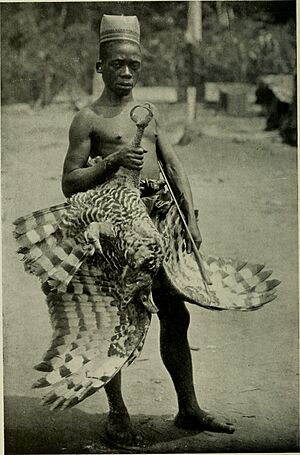
Crowned eagles are common in areas with good habitat, but their numbers are declining because of deforestation. Their main home, the rich, tall forest, is being cut down for timber, farms, and other uses. This destruction of forests is a big problem for the eagles.
Even though some new tree plantations have been made, they often don't have enough prey for the eagles. Crowned eagles are much more common in protected areas and wildlife reserves. Scientists now realize that the eagles' ability to adapt to small, broken-up patches of forest might have been overestimated. In 2012, the IUCN changed the species' status to Near Threatened, meaning they are close to becoming endangered.
Like the martial eagle, crowned eagles have sometimes been hunted by farmers who worry about their livestock. However, these eagles rarely attack farm animals. Another threat is that crowned eagles are seen as competitors in the illegal bushmeat trade. This trade involves hunting wild animals, often monkeys and small antelopes, which are the main food for crowned eagles. This removes the eagles' food source and can also lead to eagles themselves being hunted for meat.
Some people, like foresters and fruit growers, actually protect crowned eagles. They know that these eagles help control populations of mammals that can harm crops. In zoos, crowned eagles are rare. The first captive-born crowned eagle hatched at the San Diego Zoo in 1996. Because they are high-strung and can be aggressive, crowned eagles are not usually used in falconry.





